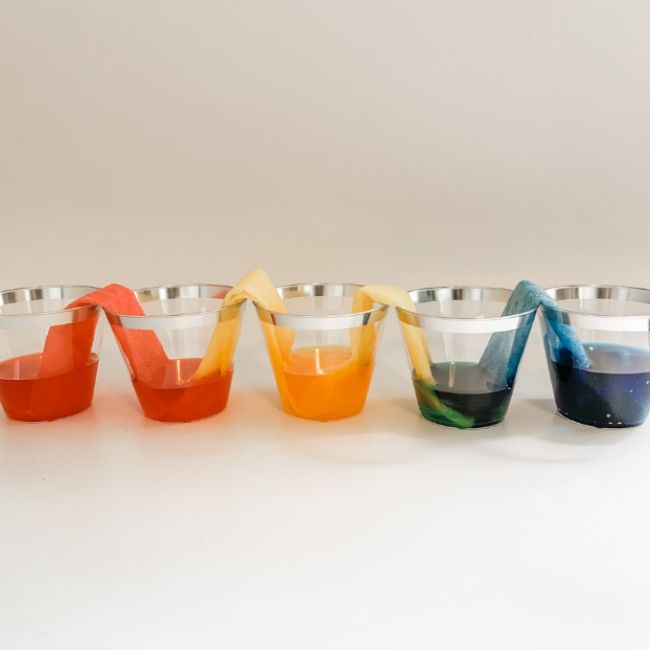
This activity is a wonderful experiment to accompany books and discussions about our many, colorful emotions. There are many helpful images that we can give to children when we are discussing emotions. Many educators like to associate emotions with specific colors, and this activity is a reminder that “our emotions pass”. When we feel angry, it might feel like we will feel angry forever! But the truth is, this emotion will pass. This is true for sadness, frustration, joy, loneliness, boredom, and more!
This experiment can take an hour or more, have the kids help set it up, go play and come back and check on it every 20 minutes or so to see the progress! In the meantime you can also read books that have to do with colors and corresponding emotions, such as My Many Colored Days by Dr. Seuss, and The Color Monster by Anna Llenas.
Set up Time: 5 minutes
Directions
- Line up 5 clear cups, the 1st, 3rd and 5th filled 3/4 of the way with water.
- Fold up a paper towel lengthwise in quarters.
- Trim the paper towel to fit the length between the cups without much excess.
- Place 10 drops of red food coloring into the 1st cup, 10 of yellow into the 3rd and 10 of blue into the 5th.
- Place the paper towels between each of the cups so they are all touching in one line.
- Watch the colors bleed through the napkin to fill the empty cups with water and as they do the colors mix to orange and green to form a rainbow!
Materials
- Clear cups
- Paper towels
- Food coloring (red, yellow, blue)
- Water
Learning Through Play
Cognitive: Problem Solving – How do children think the water is moving? What materials are we using? What shape is the paper towel?
Social-Emotional: Empowerment – Think of different ways that you can help children understand that their emotions will pass. For younger children, the important part is to be a safe, secure, and solid base for them to be able to experience their emotions. When you are calm and loving when they are having a tantrum or meltdown, it shows them that they are safe to experience their emotions, and will help them to self-regulate. There are many different strategies for supporting big emotions that vary according to the emotion, the time of day, the needs of the child, and more, and we highly recommend that educators look up resources on how to support children.
School Readiness: Sorting – As children are learning the names of different emotions, they may come up with their own ways to demonstrate the way certain emotions make them feel. For example, they may scrunch up their face to express anger, point to the color red, or say that they feel hot. Putting language to the human experience is something that artists and philosophers have sought to do for centuries, so embrace this journey with young learners and seek to give them many different ways to express and release emotions.
See this activity in the Rayz Kidz app along with other fun activities. Rayz Kidz is your trusted source for play-based activities featuring over 100 themes and 500+ hands-on activities and clear descriptions of the beautiful learning that is happening through play.